Joint Replacement
What is Joint Replacement
Joint replacement (the term orthopedic specialist’s use) is usually reserved for patients who have severe arthritic conditions. Patients are considered for total joint replacement if:
-
Arthritis restricts not only work and recreation, but also the day to day activities.
-
Pain is not relieved by more conservative methods of treatment – such as medications, physical therapy, as arthroscopy (cleaning the joint), the use of a cane and/or by restricting activities.
-
Stiffness in the joint is significant.
-
X-rays show advanced arthritis or other problems
WHAT IS JOINT REPLACEMENT SURGERY?
Joint replacement surgery is removing a damaged joint and putting in a new one. A joint is where two or more bones come together, like the knee, hip, and shoulder. The surgery is usually done by a doctor called an orthopaedic surgeon. Sometimes, the surgeon will not remove the whole joint, but will only replace or fix the damaged parts.

The doctor may suggest a joint replacement to improve how you live. Replacing a joint can relieve pain and help you move and feel better. Hips and knees are replaced most often. Other joints that can be replaced include the shoulders, finger, ankles, and elbows.
KNEE REPLACEMENT SURGERY
Total knee replacement (TKR) is a surgical procedure where worn, diseased or damaged surfaces of the knee joint are removed and replaced with artificial surfaces.
Understanding your knee joint
The healthy knee : the healthy knee joint is a remarkable mechanism. It is formed by the bottom end of the femur (thigh bone), the top of the tibia (shin bone) and the patella (knee cap). A healthy knee joint has cartilage between the bones that acts as padding. This padding helps assure a gliding movement of the knee that is both effortless and smooth. The healthy knee joint also has a joint capsule which houses the synovial membrane. This membrane produces lubricating fluid which contributes to the smooth movement of the knee

The human knee is designed to withstand a lifetime of stressful activity. However, sometimes arthritis intrudes, interfering with the knee’s ability to cushion the body from stress, and eventually causing the pain that dramatically erodes your quality of life.
you need to know about knee Replacement surgery All
-
Osteoarthritis resulting from “wear and tear” of the knee is the most common reason individuals need to undergo knee replacement surgery.
-
Rheumatoid Arthritis, injury and infection may also lead to a need for knee replacement surgery.
-
The decision to have a knee replacement is based on whether the painful destroyed knee is significantly affecting a person’s day to day living.
-
Total knee replacement (TKR) is designed to provide painless and unlimited standing, sitting, walking, and other normal activities of daily living.
-
Improved surgical tools & procedures have led to artificial joint replacement for arthritis of the hip and knee as two of the most successful surgeries of the last century.
-
The choice of surgical procedure and the type of implant depends on the surgeon’s preference and the individual patient’s requirements.
-
Materials used for resurfacing of the joint are not only strong and durable but also optimal for joint functions they produce as little friction as possible.

-
The artificial joint or ‘prosthesis’ generally has two components, one made of metal which is usually cobalt – chrome or titanium. The other component is a plastic material called polyethylene.
-
The artificial implant is fixed to bone by either a cemented procedure or non-cemented procedure. This will usually affect whether one can fully weight bear or only toe-touch for the first six weeks following surgery.
-
Some of the most common complications following knee replacement are deep venous thrombosis (DVT), infection, stiffness and loosening of the implant.
-
Postoperative care begins with a team approach of the health professionals within the hospital which include nurses, physical therapists, respiratory therapists and occupational therapists.
-
Once the postoperative total knee patient has progressed to a point where they are no longer homebound from their surgery, the patient may be a candidate for outpatient physical therapy services.
-
With proper care, individuals who have undergone total knee replacement can expect a greater than ninety-five percent chance of success for at least 15 years.
The procedure has been proven to help individuals return back to moderately challenging activities such as golf, bicycling, and swimming. Total knees are not designed for jogging, or sports like tennis and skiing (although there certainly are people with total knee replacements that participate in such sports).
INDICATIONS FOR TOTAL KNEE REPLACEMENT
-
Deterioration of the knee joint cartilage (osteoarthritis).
-
Inflammation in the lining of the knee joint (rheumatoid arthritis).
-
Physical injury to the knee joint resulting in arthritis (traumatic arthritis).
-
Moderate valgus (knock-kneed), varus (bowlegged), or flexion (bending) deformities.
-
A loss of blood supply to the lower portion of the upper leg bone (femoral condyle) which leads to tiny breaks within the bone and possible collapse (avascular necrosis).
-
To correct problems caused by previously failed surgeries.
-
Certain breaks in the knee joint bones (fractures).
If You Are Considering Total Knee Replacement Surgery
If you have been told you have a severely damaged knee joint and would benefit from a TKR, the questions you need to ask yourself are:
-
Have all of the appropriate non-surgical treatments been tried.
-
Is my painful knee significantly restricting my day to day activities and not allowing me to do the things I need to do and the things I enjoy doing?
If the answers to these questions are yes, you may be a candidate for a new knee.
Types of Knee Joints Available and Recommendations
1. The fixed bearing knee surfaces where the top of tibal (leg bone) and lower end of femur (thigh bone) are approximating are fixed by bone cement. There is no movement of the bearing surface viz a viz the bone platform. This type of joint is time tested and has been used world over for more than 25 years and is generally successful.
2. Mobile bearing or rotating platform is a variety where the top of leg-bone provides mobile surface and this joint is considered to be having less wear & tear and therefore longer life. The last word about the authenticity of the tall claim is yet to come. The implant is otherwise successful.
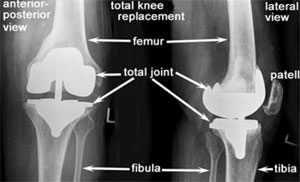
3. Third variety is high flexion knee which is supposed to provide more bending of the knee i.e. up to 150-160 degrees. This happens because of its construct but in practice many a times it may not be realized. This knee is more expensive than the earlier two knees. As a matter of wisdom in scientific world it has been established that flexion of knee post operatively depends more on its preoperative range of movement and technique and postoperative physiotherapy. The make per say is not all.
4. The constrained knee variety is meant for unstable knee where deformity is more i.e. the leg is bent on one or the other side excessively and support of side-bands (collateral ligaments) is not good enough. Also this knee is used for revision of failed primary knee replacements. Its cost is almost double the amount of primary knee implant.
Hip Replacement Surgery
Know Your Hip Joint
The hip region is located lateral to the gluteal region (i.e. the buttock), inferior to the iliac crest, and overlying the greater trochanter of the thigh bone.[2] In adults, three of the bones of the pelvis have fused into the hip bone which forms part of the hip region.
The hip joint, scientifically referred to as the acetabulofemoral joint (art. coxae), is the joint between the femur and acetabulum of the pelvis and its primary function is to support the weight of the body in both static (e.g. standing) and dynamic (e.g. walking or running) postures.
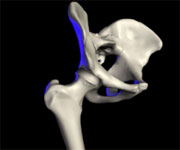
Indicators of Total Hip Replacement:
Total hip replacement is most commonly used to treat joint failure caused by osteoarthritis. Other indications include rheumatoid arthritis, avascular necrosis, traumatic arthritis, protrusio acetabuli, certain hip fractures, benign and malignant bone tumors, arthritis associated with Paget's disease, ankylosing spondylitis and juvenile rheumatoid arthritis. The aims of the procedure are pain relief and improvement in hip function. Hip replacement is usually considered only once other therapies, such as physical therapy and pain medications, have failed.
Total Hip Replacement
A total hip replacement (THR) is a surgical procedure whereby the diseased cartilage and bone of the hip joint is surgically replaced with artificial materials. The normal hip joint is a ball and socket joint. The socket is a “cup-shaped” bone of the pelvis called the acetabulum. The ball is the head of the thigh bone (femur). THR involves surgical removal of the diseased ball and socket and replacing them with a metal ball and socket and replacing them with a metal ball and stem inserted into the femur bone and an artificial plastic cup socket. The metallic artificial ball and stem are referred to as the “prosthesis.” Upon inserting the prosthesis into the central core of the femur, it is fixed with a bony cement called methylmethacrylate. Alternatively, a “cementless” prosthesis is used which has microscopic pores that allow bony ingrowth from the normal femur into the prosthesis stem. This “cementless” hip is felt to have a longer duration and is considered especially for younger patients.
Shoulder Joint Replacement
Although shoulder joint replacement is less common than knee or hip replacement, it is just as successful in relieving joint pain.
Over the years, shoulder joint replacement has come to be used for many painful conditions of the shoulder, such as severe fractures and arthritis.
If nonsurgical treatments like medications and physiotherapy are no longer helpful for relieving pain, you may consider shoulder joint replacement surgery. Joint replacement surgery is a safe and effective procedure to relieve pain and help you resume everyday activities.
Anatomy
Your shoulder is made up of three bones: your upper arm bone (humerus), your shoulder blade (scapula), and your collarbone (clavicle). The shoulder is a ball-and-socket joint: The ball, or head, of your upper arm bone fits into a shallow socket in your shoulder blade. This socket is called the glenoid.
The surfaces of the bones where they touch are covered with articular cartilage, a smooth substance that protects the bones and enables them to move easily. A thin, smooth tissue called synovial membrane covers all remaining surfaces inside the shoulder joint. In a healthy shoulder, this membrane makes a small amount of fluid that lubricates the cartilage and eliminates almost any friction in your shoulder.
The muscles and tendons that surround the shoulder provide stability and support.
All of these structures allow the shoulder to rotate through a greater range of motion than any other joint in the body.
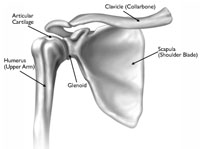
The bones of a healthy shoulder joint.
Description
In shoulder replacement surgery, the damaged parts of the shoulder are removed and replaced with artificial components, called prosthesis. The treatment options are either replacement of just the head of the humerus bone (ball), or replacement of both the ball and the socket (glenoid).
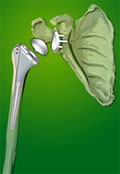
Shoulder joint replacement.
Total Elbow Replacement
Although elbow joint replacement is much less common than knee or hip replacement, it is just as successful in relieving joint pain and returning people to activities they enjoy.
Anatomy
The elbow is a hinge joint which is made up of three bones
-
The humerus (upper arm bone)
-
The ulna (forearm bone on the pinky finger side)
-
The radius (forearm bone on the thumb side)
The surfaces of the bones where they meet to form the elbow joint are covered with articular cartilage, a smooth substance that protects the bones and enables them to move easily. A thin, smooth tissue called synovial membrane covers all remaining surfaces inside the elbow joint. In a healthy elbow, this membrane makes a small amount of fluid that lubricates the cartilage and eliminates almost any friction as you bend and rotate your arm.
Muscles, ligaments, and tendons hold the elbow joint together.

The main structures of the elbow when viewed from the side.
Description
In total elbow replacement surgery, the damaged parts of the humerus and ulna are replaced with artificial components. The artificial elbow joint is made up of a metal and plastic hinge with two metal stems. The stems fit inside the hollow part of the bone called the canal.
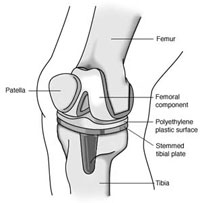
Total elbow replacement components.
There are different types of elbow replacements, and components come in different sizes. There are also partial elbow replacements, which may be used in very specific situations. A discussion with your doctor will help to determine what type of elbow replacement is best for you.



